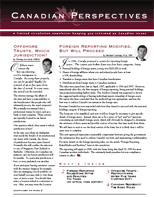
PDF Format
 Issue Contents Issue Contents
 All Issues All Issues
Canadian Perspectives - September 1998
The information in this edition of Canadian Perspectives is prepared for general interest only. Every effort has been made to ensure that the contents are accurate as of September, 1998 but professional advice should always be obtained before acting on the information herein.
Offshore Trusts Restructuring After Five Years
By Michael Cadesky, FCA, TEP
Cadesky and Associates LLP (Toronto)
In previous issues of Canadian perspectives, we discussed the use of an offshore trust for immigrant tax planning. Generally, this trust has a usefulness of five years, and at the end of that period, a decision has to be made on whether to keep the trust, modify the trust, or liquidate it entirely. In this article we will use an example of Mr. Lee who set up an offshore trust for his wife and three children. An immigrant trust will be exempt of Canadian tax until the beginning of the year in which the person who has contributed property to the trust in the first place (usually the settlor) has been a resident of Canada for 60 months or more. For example, if the trust was established by Mr. Lee in April, 1994 who became resident in Canada at that time, the trust would become taxable effective for 1999 (i.e. January 1, 1999). There are four types of plans that can be considered for an offshore trust at the end of the five year period. Each of these is discussed below. If the original contributor of property to the trust (Mr. Lee in our example) becomes a non-resident of Canada before being resident for 60 months in his lifetime, then the trust can continue to be exempt of Canadian tax. Therefore, Mr. Lee must become a nonresident before March 31, 1999. If not, the trust is deemed to be Canadian resident effective January 1, 1999. However, it can become non-resident again if Mr. Lee later leaves Canada, after an 18 month waiting period. Often it is not feasible for the settlor to become a non-resident. Perhaps Mr. Lee likes living in Canada and does not want to leave. So here is the second alternative. Suppose two of his children now live outside Canada. If the Canadian beneficiaries are deleted absolutely and permanently before January 1, 1999, then the trust will not become taxable by Canada. A third alternative is to allow the trust to become taxable by Canada, but to ensure that it does not then retain any income. A trust can generally allocate income to a beneficiary, which makes the income taxable in the hands of the beneficiary and not in the trust. Therefore, suppose in the Lee Trust, the income is allocated to the non-resident children. The trust itself would then have no tax liability. If the beneficiaries are non-residents, then they would not normally be taxable by Canada on receiving this income if it is non-Canadian source. A fourth alternative is to make the trust a resident of Canada. This has two main benefits. The first is that the act of making the trust a Canadian resident causes the trust to have a year end. If done immediately before the 60th month expiry date, the full 60 months exemption period can be obtained. For example, if the Lee Trust above were to become a Canadian resident on March 31, 1999, the income from January 1, 1999 to that date would be exempt of Canadian tax. Otherwise, this income would be taxable. The second advantage of this planning is that the assets of the trust are re-valued to fair market value (with the exception of certain Canadian assets). Suppose the Lee Trust had a U.S. stock portfolio which had appreciated in value during the five years of the trust's existence. If the trust became a resident of Canada, this appreciation would not be subject to Canadian tax. In planning to restructure five year immigrant trusts, there are four main planning alternatives. Each is quite different from the others. The alternative which will work the best in any particular case will depend very much on the facts of that case. Each situation deserves personal attention, in order to arrive at the best possible solution. One last thought to keep in mind: It is often necessary to carry out the tax planning one year before the year in which the trust's exemption will end. Do not underestimate the time it will take to complete the restructuring process. Start early.
| 




